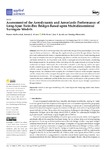Mostrar o rexistro simple do ítem
Assessment of the Aerodynamic and Aeroelastic Performance of Long-Span Twin-Box Bridges Based upon Multidimensional Surrogate Models
| dc.contributor.author | Badhurshah, Rameez | |
| dc.contributor.author | Álvarez Naveira, Antonio José | |
| dc.contributor.author | Nieto Mouronte, Félix | |
| dc.contributor.author | Jurado, José Ángel | |
| dc.contributor.author | Hernández, Santiago | |
| dc.date.accessioned | 2024-07-02T13:18:11Z | |
| dc.date.available | 2024-07-02T13:18:11Z | |
| dc.date.issued | 2024 | |
| dc.identifier.citation | Badhurshah, R.; Álvarez, A.J.; Nieto, F.; Jurado, J.Á.; Hernández, S. Assessment of the Aerodynamic and Aeroelastic Performance of Long-Span Twin-Box Bridges Based upon Multidimensional Surrogate Models. Appl. Sci. 2024, 14, 5531. https://doi.org/10.3390/app14135531 | es_ES |
| dc.identifier.uri | http://hdl.handle.net/2183/37641 | |
| dc.description.abstract | [Abstract:] Twin-box decks are being extensively used in the design of long-span bridges due to their superior flutter performance. Although the significant role played by the gap distance has been previously addressed in the frame of experimental studies, there is still a lack of understanding about the complex interplay between box geometry, gap distance and the aerodynamic force coefficients and flutter derivatives. In the present work, firstly, a surrogate model is developed, considering three design inputs for the geometry of the deck along with the angle of attack, providing the force coefficients as output. Afterwards, the work is then extended by developing another surrogate model, considering as inputs the reduced velocity and the same geometric variables of the deck, with the outputs being the flutter derivatives. The methodology, comprising the selection of the design domain, the definition of the samples, the CFD-based evaluation of the samples' response and the construction of the surrogate through the application of the neural network-based radial basis method, is reviewed. The surrogate models enable a quantitative description of the impact caused in the force coefficients and the flutter derivatives by modifications in the geometry of the twin-box deck. It has been found that flutter derivatives H∗1 , H∗2 and A∗2 are strongly dependent on the gap distance. | es_ES |
| dc.description.sponsorship | This research has been supported by the grant PID2019-110786GB-I00 and the grant PID2022-138069OB-I00, funded by Ministry for Science and Innovation of Spain MICIU/AEI/10.13039/501100011033 and, by “ERDF A way of making Europe”, along with the grant ED431C 2021/33 funded by the Galician Regional Government, including FEDER funds. | es_ES |
| dc.description.sponsorship | Xunta de Galicia; ED431C 2021/33 | es_ES |
| dc.language.iso | eng | es_ES |
| dc.publisher | MDPI | es_ES |
| dc.relation | info:eu-repo/grantAgreement/AEI/Plan Estatal de Investigación Científica y Técnica y de Innovación 2017-2020/PID2019-110786GB-I00/ES/OPTIMIZACION DE FORMA Y ANALISIS DE SEGURIDAD COMPUTACIONAL Y AEROESTRUCTURAL DE TABLEROS DE PUENTES DE CABLES DE GRAN VANO CONSIDERANDO MULTIPLES FENOMENOS AEROELASTICOS | es_ES |
| dc.relation | info:eu-repo/grantAgreement/AEI/Plan Estatal de Investigación Científica y Técnica y de Innovación 2021-2023/PID2022-138069OB-I00/ES/OPTIMIZACION PROBABILISTA DE PUENTES DE GRAN VANO SOPORTADOS POR CABLES, DE TABLEROS MULTI-CAJON, EN FLUJO DE VIENTO LAMINAR Y TURBULENTO CON MULTIPLES VARIABLES ALEATORIAS | es_ES |
| dc.relation.uri | https://doi.org/10.3390/app14135531 | es_ES |
| dc.rights | Atribución 3.0 España | es_ES |
| dc.rights.uri | http://creativecommons.org/licenses/by/3.0/es/ | * |
| dc.subject | Twin-box | es_ES |
| dc.subject | Surrogate modelling | es_ES |
| dc.subject | CFD | es_ES |
| dc.subject | Latin Hypercube Sampling | es_ES |
| dc.subject | Radial basis | es_ES |
| dc.subject | Flutter | es_ES |
| dc.subject | URANS | es_ES |
| dc.subject | k-ω SST | es_ES |
| dc.title | Assessment of the Aerodynamic and Aeroelastic Performance of Long-Span Twin-Box Bridges Based upon Multidimensional Surrogate Models | es_ES |
| dc.type | info:eu-repo/semantics/article | es_ES |
| dc.rights.access | info:eu-repo/semantics/openAccess | es_ES |
| UDC.journalTitle | Applied Sciences | es_ES |
| UDC.volume | 14 | es_ES |
| UDC.startPage | 5531 | es_ES |
| dc.identifier.doi | 10.3390/app14135531 |
Ficheiros no ítem
Este ítem aparece na(s) seguinte(s) colección(s)
-
CITEEC-ME - Artigos [24]






